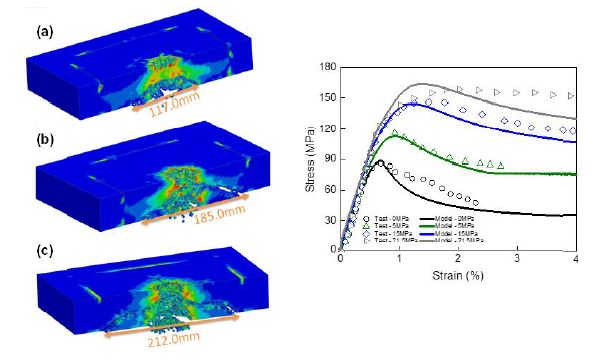Video Article Open Access
Numerical simulation of impact resistance of steel fibre reinforced concrete
Xiaoshan Lin*, Lei Yang
RMIT University, Melbourne, 3000, Australia
Vid. Proc. Adv. Mater., Volume 1, Article ID 2020-0813 (2020)
DOI: 10.5185/vpoam.2020.0813
Publication Date (Web): 06 Aug 2020
Copyright © IAAM
Graphical Abstract

Abstract
Nowadays, impact and blast resistance has become crucial in the design of engineering structures, especially for those strategically important infrastructures. The use of steel fibre reinforced concrete in protective structures has gained worldwide interest due to its superior mechanical characteristics, such as its high strength, excellent energy absorption ability, improved strain capacity and good fatigue resistance. In recent decades, with the development of computational power, explicit finite element codes, such as LS-DYNA and AUTODYN, have been widely used in the studies of dynamic behaviour of engineering structures. At present, to simulate the dynamic behaviour of steel fibre reinforced concrete structural components subjected to intense impact loads, material models for normal concrete have been commonly used. However, as these material models are originally proposed for normal concrete, they may not be able to effectively capture the material behaviour of steel fibre reinforced concrete. Another issue to be concerned in modelling dynamic behaviour of steel fibre reinforced concrete structures is the strain-rate effect. The mechanical properties of steel fibre reinforced concrete are very sensitive to strain rate, and much higher material strength can be obtained when subjected to high velocity impact and blast loads. In this talk, finite element models recently developed for simulating the responses of steel fibre reinforced concrete to impact and blast loads will be introduced. A new constitutive material model will also be discussed, in which the damages are properly described by treating the plastic shear strain and the volumetric strain separately. A newly developed dynamic increase factor model is employed to characterise the effect of strain rate on the strength in both compression and tension, where the influences of matrix strength, fibre type and fibre dosage on the strain-rate sensitivity of steel fibre reinforced concrete are taken into account. The new material model could accurately capture the mechanical behaviours of steel fibre reinforced concrete with simple input parameters. Several numerical examples will also be presented to demonstrate the effectiveness of the proposed finite element model.
Keywords
Steel fibre reinforced concrete; numerical simulation; dynamic increase factor; constitutive material model.
Acknowledgement
Steel fibre reinforced concrete, numerical simulation, dynamic increase factor, constitutive material model.
Biography
Xiaoshan Lin is a Lecturer in Structural Engineering at Royal Melbourne Institute of Technology (RMIT University) in Australia. She received her PhD degree in Civil Engineering from the University of New South Wales in Australia. Before joined RMIT University, Dr Lin had been working on different research projects in Australia, UK and Singapore. Dr Lin has extensive research experience in the studies of composite materials and structures, aiming to enhance the performance of civil engineering structures. She also has a strong expertise in using advanced numerical techniques for material calibration and structural analysis under extreme loading conditions, e.g. impact/blast/fire loadings. Dr Lin has well established international collaborations and has been involved in research projects funded by various schemes.
Video Proceedings of Advanced Materials

Upcoming Congress



